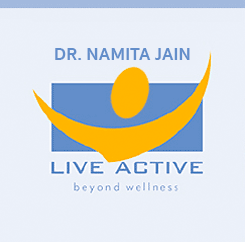
Key nutrients
Beta-carotene, potassium, Calcium, phosphorus, iron, Vitamins A, B3, C
Benefits
Tomato detoxifies the liver, purifies the blood and improves digestion. A rich source of Vitamin A, it helps treat eye problems. It is also helps control blood sugar levels (for diabetics) and improves immunity levels.
Key nutrients
Vitamin B3, calcium, iron, curcumin
Benefits
Turmeric contains curcumin, a powerful antioxidant chemical that helps relieve inflammation, making it useful for easing autoimmune conditions such as rheumatoid arthritis and allergies. Curcumin prevents build-up of fatty deposits in the arteries and helps protect against heart disease.
Key nutrients
Protein, B-Vitamins, calcium, phosphorous, iron, sodium, potassium
What is tofu?
Tofu is a processed soybean curd. Making tofu involves the process of soaking, blending and cooking soybeans and mixing them with a natural solidifier (lemon juice).
Tofu has a firm, custard-like consistency and a bland flavor. It comes in different degrees of firmness, depending on how much water has been removed. Extra-firm tofu is good for stir-frying, silken tofu is ideal for smoothies, puddings and baking.

A hot cup of tea may do more than relax you…not only is tea soothing and refreshing, it also has health benefits.
Benefits
Tea, whether black, green or red, contain polyphenols which give tea its antioxidant properties. Antioxidants protect the body from free radical damage and build immunity levels. Some studies have suggested the anti-cancer properties of polyphenols and also the lowering of cholesterol levels in the body.
Green tea is the least processed tea. Black tea undergoes more processing and that is why is dark in colour. Black and red teas are oxidized, partially dried, crushed and fermented.
Tea ranks as high as many of the fruits and vegetables in their antioxidant measure, regardless of their processing method.
According to the American Dietetic Association, a cup of tea contains an average of 40mg of caffeine, compared to 85mg found in a cup of coffee.
Brew your tea for 3 to 5 minutes to bring out the benefits of the polyphenols. Enjoy the aroma!
The Tibetans is the name given to a set of five dynamic yogic exercises for improving health, energy and focus. These exercises, also known as the ‘Five Rites of Rejuvenation’, affect the innate energetic power of the human mind, body and soul.
Benefits
The five Tibetans stimulate energy flow through the chakras or energy centers and enliven the corresponding nerves, organs and glands. Regular practice relieves muscular tension, nervous stress, improves respiration, digestion and functioning of the cardiovascular system.
All you need is about five minutes a day for the practice of these exercises.It is best to practice these rights early in the morning or three hours after eating food.
These exercises are ideally practised twenty-one times (each). In the beginning you can start out with eleven repetitions and then work your way up.
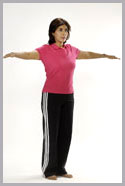 Stand up straight with your arms outstretched to the sides. Fingers are together, palms facing downward. Holding this arm position, spin full circle in a clockwise direction.
Stand up straight with your arms outstretched to the sides. Fingers are together, palms facing downward. Holding this arm position, spin full circle in a clockwise direction.
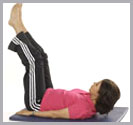 Lie on your back on a mat. Your legs are fully extended and arms are by your side. Inhale, and lift your legs up to a ninety-degree angle, and raise your head, tucking your chin into your chest. Exhale, and return to starting position.
Lie on your back on a mat. Your legs are fully extended and arms are by your side. Inhale, and lift your legs up to a ninety-degree angle, and raise your head, tucking your chin into your chest. Exhale, and return to starting position.
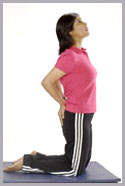 Sit in a kneeling position. Your knees should be about four inches apart. Place your palms against the back of your thighs just below your hips. Your spine should be erect and chin tucked into your chest. Inhale, and arch backwards dropping your head as far back as you comfortably can, exhale, and return to starting position.
Sit in a kneeling position. Your knees should be about four inches apart. Place your palms against the back of your thighs just below your hips. Your spine should be erect and chin tucked into your chest. Inhale, and arch backwards dropping your head as far back as you comfortably can, exhale, and return to starting position.
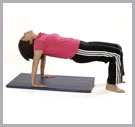 Sit up tall with your legs outstretched in front of you. Place the palms of your hands on the ground beside your hips. Inhale, and raise your hips as you bend your knees, bringing the soles of your feet flat to the ground as you drop your head all the way back. Your trunk should be parallel to the floor. Exhale, and return to starting position.
Sit up tall with your legs outstretched in front of you. Place the palms of your hands on the ground beside your hips. Inhale, and raise your hips as you bend your knees, bringing the soles of your feet flat to the ground as you drop your head all the way back. Your trunk should be parallel to the floor. Exhale, and return to starting position.
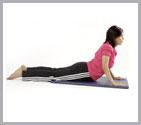 Begin this exercise by supporting yourself on the palms of your hands and your feet (the Upward facing Dog Pose), your head is up and back. Inhale, as you get into this position. Exhale, as you lift your legs, hips and spine off the floor, bringing your body up into a perfect triangle (the Downward Dog Pose).
Begin this exercise by supporting yourself on the palms of your hands and your feet (the Upward facing Dog Pose), your head is up and back. Inhale, as you get into this position. Exhale, as you lift your legs, hips and spine off the floor, bringing your body up into a perfect triangle (the Downward Dog Pose).
Thyroid
The thyroid gland is situated at the front of the neck surrounding the windpipe. The thyroid hormones regulate the metabolic rate of many tissues. If the thyroid gland under or overproduces the two thyroid hormones T3 and T4, the condition is referred to as hypothyroidism or hyperthyroidism.
An underactive thyroid causes levels of T3 and T4 to be low.
Typical symptoms include:
- Weight gain
- Tiredness
- Feeling low
An overactive thyroid is quite common and more often seen in women.
Typical symptoms include:
- Feeling restless
- Loss of weight
- Low tolerance of heat
Depending on symptoms the physician might recommend medication,
changes in lifestyle, diet and activity patterns or even surgery.
Tiredness
A wide range of conditions such as underactive thyroid glands, low sugar levels, lack of oxygen in the blood, over-strain, insufficient sleep, stress or depression can cause tiredness.
Most people lead hectic lives, and are compelled to cope with demands and strains the body is not designed to handle. This in time leads to build-up of fatigue. Take a look at your lifestyle. Figure out which areas of your life need to be reviewed. And make the necessary changes. These changes will improve the quality of your life.
- Are you skipping meals or eating too much fast food?
- Are you sleeping enough?
- Do you take time out to exercise?
- Are you consuming too much caffeine, alcohol or cigarettes?
- Do you spend enough time with people you really enjoy being with?
- Do you find ways to unwind and de-stress?
If you exhaust your resources – emotional, mental and physical you will in time be “burning the candle at both ends”. Good health is all about making small changes in your diet, physical activity and your attitude towards life; and incorporating the positive changes until they become habits. It’s not always easy and you need to take small steps slowly, rather than one giant leap.
 You need to put in your time at work, visit the dentist, get the car serviced… but you have to pay attention to your body, mind and soul, as well.
You need to put in your time at work, visit the dentist, get the car serviced… but you have to pay attention to your body, mind and soul, as well.
Phones, faxes, e-mail, the cell phone, you are always accessible. You can’t run away and you can’t hide. But you can schedule your time to include time-outs. With a little planning and prioritizing you will be able accomplish what is really important to you. Manage your time well so you can live and love life.
